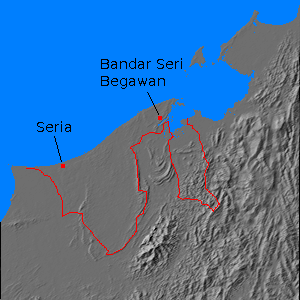![]() The Pacific War Online Encyclopedia
The Pacific War Online Encyclopedia
|
| Previous: Bruce, Andrew D. | Table of Contents | Next: Brush, Rapp |

In 1941, Brunei was a British
protectorate on the northwest coast of Borneo.
The chief city is Bandar
Seri Begawan and there was an important oil
field at Seria, which produced sufficient wealth that the sultan of Brunei was able to build the largest mosque in the Far East. Rubber was also produced. Brunei Bay
was a
large (500 square miles or 1300 km2) sheltered anchorage.
The population in 1941 was about 39,000.
Brunei fell to elements of the Japanese 142 Regiment and 2 Yokosuka SNLF on 15-16 December 1941.
Brunei Death March. On 23 January 1945 a group of 157 European began a journey from Labuan to Kuching that none would survive. By 8 June, when the group reached Miri, 117 had already died of disease and mistreatment. When a British invasion fleet
was spotted on 8 June, the Japanese moved the survivors inland, and on
10 June the Japanese sergeant major in charge of the group, Sugino
Tsuruo, ordered them shot to prevent their liberation by the Allies.
Sugina was hanged by the Australians after the war.
Liberation. The area was recaptured by elements of the Australian 9 Division (reinforced to 31,000 troops) during OBOE III, 13 June 1945. The Japanese defenders were 56 Independent Mixed Brigade, 25 Independent Mixed Regiment, and elements of 22 Special Base Force and 2 Guard Force, totalling about 5000 troops.
The Australian invasion plan was a complex one, calling for two landings separated by 20 miles (32 km), one at Labuan
and the other on the spit on the southwest side of the bay. A third
smaller landing would take place on Muara Island near the location of
the second landing. Extensive minesweeping
preceded the landings, beginnin on 22 April 1945 and continuing to 29
April. After a pause, a second minesweeper force swept the bay from7
June to 9 June. During this second operation, miinesweeper Salute hit a mine and eventually sank.
Landings commenced on 10 June 1945. The only opposition to the landings was a single Ki-45 Nick that dropped a single bomb (missing its target) and escaped through heavy but inaccurate antiaircraft fire. The first serious opposition ashore came as the troops approached Labuan airfield. The Japanese
retreated into "The Pocket", a stronghold in a mangrove swamp at the
head of the harbor, and it took until 21 June to reduce the stronghold.
The fighting cost at least 400 Japanese killed and devastated
Victoria.
The landings at Brunei Bay encountered no opposition and the troops
advanced to capture Bandar Seri Begawan by 15 June 1945. Seria fell on
21 June. The whole of North Borneo was secured by 1 July. Total casualties were 114 Australian and 4 American dead. In addition, Admiral Royal, the landing force commander, died suddently of a heart attack on 18 June 1945, which was attributed to stress and overwork.
By 12 June 1945 the minesweepers had swept a total of 102 mines, and
moved on to the Miri area, where they swept another 338 mines.
References
Morison (1959)
The Pacific War Online Encyclopedia © 2007, 2010-2012 by Kent G. Budge. Index